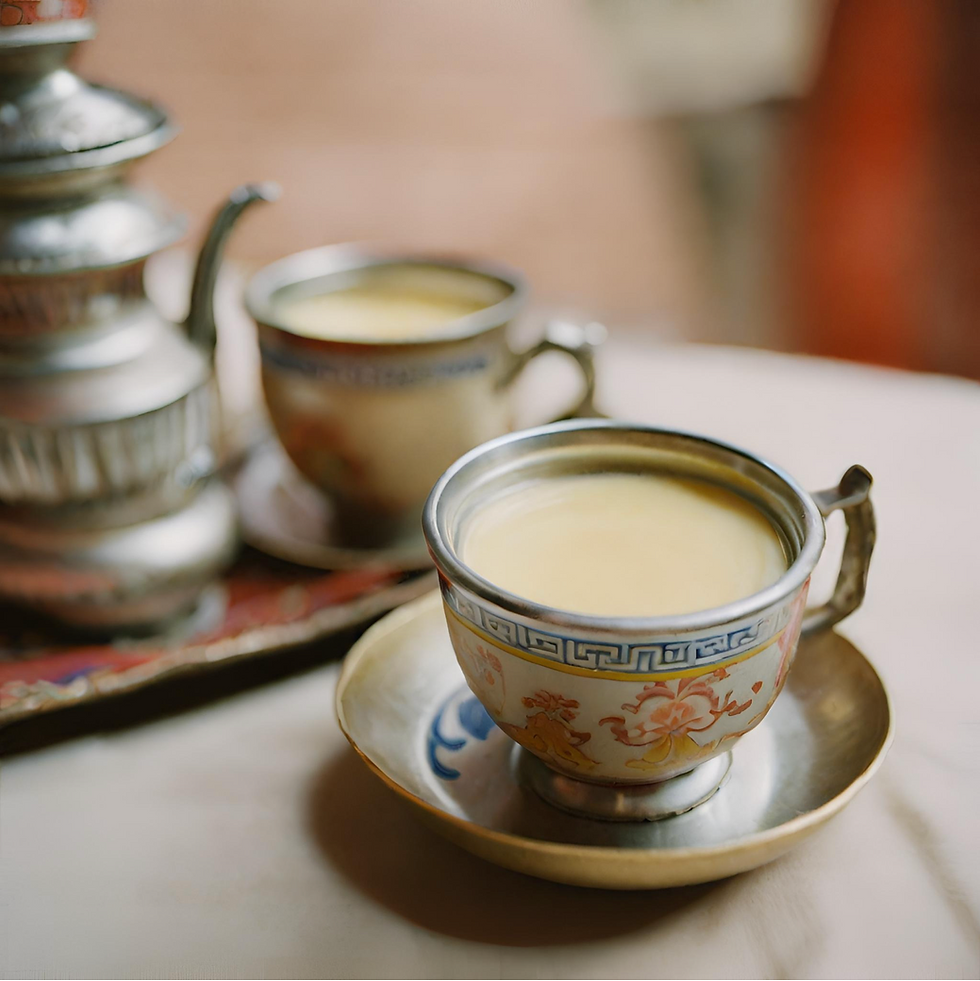What is Tibetan Butter Tea (Po Cha)?
- Amy Aed

- Mar 2, 2024
- 3 min read
Tibetan Butter Tea, also known as Po Cha, is a tea made from black tea, salt, and creamy yak butter. Revered across the vast landscapes of Tibet and Mongolia, it is served at weddings, funerals, and everything in-between.

What is Butter Tea good for?
Butter Tea is particularly suited to high altitudes due to the fact that it is filling, fatty, and filled to the brim with calories. It can help to soothe skin which has been chilled and chapped by the wind, making it perfect for those who live in the Himalayas.
How to Drink Tibetan Butter Tea
Butter Tea is typically served in cups made from silver or wood, which are sometimes then set with copper, silver, or jade. These gorgeous little cups are regarded as a status symbols and are often handed down from generation to generation.
When presented with a cup of Po Cha amidst the lofty peaks, drink it in separate sips, allowing the host to refill the cup after each sip. Should the host offer barley wine, honour the moment with three respectful flicks, symbolising homage to the Buddha, Dharma, and Sangha.
Once you are filled to the brim with tea, you should leave a small amount of tea untouched until the time comes to leave - otherwise, the cup will continue to be replenished. Then, drain the bowl, ensuring that you don't offend your host.
If they offer you a gift of butter wine then you should abstain from touching the rim. Pour yourself a glass and savour it in its entirety, as a gesture of gratitude and kinship.

Wedding and Funeral Rituals of Tibetan Butter Tea
During Tibetan weddings, Butter Tea is served to guests as a gesture of welcome and blessing. Guests sip the tea in small, ceremonial cups, each sip representing a wish for the couple's happiness and prosperity. When the couple shares a sip, it marks the beginning of a new chapter filled with love and togetherness.
During funeral ceremonies, Butter Tea is served to attendees as a symbol of support and empathy, offering warmth and sustenance during a difficult time. Each sip carries with it memories of the departed and prayers for their peaceful journey into the afterlife.
Sharing Butter Tea at funerals fosters a sense of communal mourning and solidarity, reminding mourners that they are not alone in their grief and that their loved one's spirit lives on in the memories and traditions they leave behind.
What is Mongolian Butter Tea?
In Mongolia, they mix together green or black tea with butter or fat, and then add salt. This mixture is called hiitsei tsai.
At the centre of the Mongolian tea ceremony is the matriarch. If she ever has guests but forgets to offer them tea, then she may be considered as Tsai ch ugui, tsarai ch ugui ail, meaning that she is either lazy or cheap.
Once the matriarch has made the tea, she must do the 'spraying of tea' ritual. This is where she will offer the tea to Father Sky and Mother Earth, showing respect and worship for them. Then, she will offer it to her husband, before offering it to her eldest child.
Depending on the ethnicity, region, and tribe, Mongolian butter tea could be made from one of over 20 different recipes.

Himalayan Butter Tea
Butter tea is popular across the whole Himalayas, and can be found in regions of India, Nepal, Bhutan, and Western regions of China.
In the timeless tradition of Butter Tea, each sip holds not just warmth and flavour but a profound connection to rich cultural Himalayan heritage. It's more than just a drink - it's a testament to the resourcefulness of people in crafting sustenance and warmth amidst the harshest of environments.
It hasn't quite made its way to the UK yet... but we're hopeful that someday soon, we can try a traditional sūyóu chá (Mandarin butter tea) or gur gur cha (Ladakhi butter tea)!



Comments